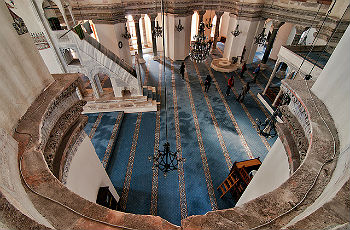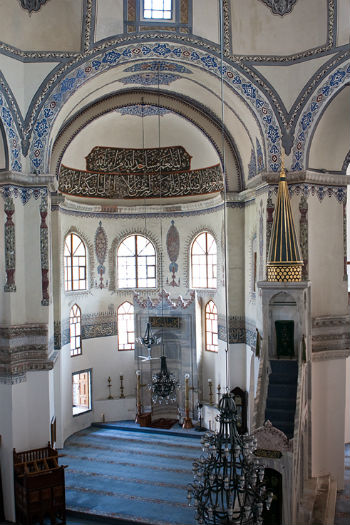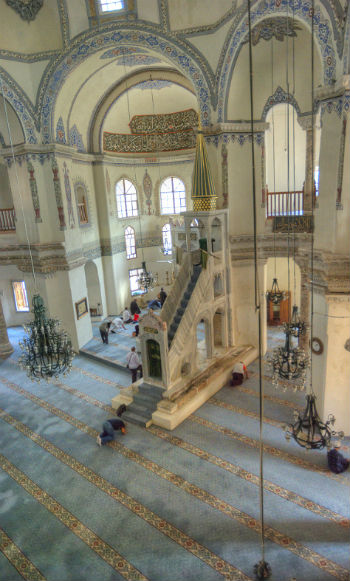Begun in 527 by Emperor Justinian, the Church of Saints Sergius and Bacchus in Istanbul was an early experiment in Byzantine architecture, with a large central dome supported by an octagonal base. The church is now a mosque called Küçük Ayasofya Camii (Little Hagia Sophia Mosque), named for its resemblance to the much larger Hagia Sophia built a few years later.
History
Saints Sergius and Bacchus are Christian Roman soldiers who were martyred in Syria in 303 AD. They became the patron saints of soldiers and their cult was very popular in Syria and beyond.
The Byzantine Emperor Justinian (r. 527-65) was among the saints’ devotees. According to legend, when Justinian was a young man he was condemned to death for plotting against Emperor Anastasius. But Sergius and Bacchus appeared to the emperor in a dream, convincing him to release Justinian.
Justinian began construction on a church dedicated to Sts Sergius and Bacchus immediately after becoming emperor himself in 527 AD; it was completed by 536 AD. The architect was Anthemius of Tralles, a mathematician and the author of a book on burning mirrors, the Paradoxographia. The chosen site was just inside the sea walls west of the Hormisdas Palace (where Justinian lived before ascending the throne), next to the Hippodrome.
The church was connected to a three-aisled basilica dedicated to St. Peter and St. Paul, which Justinian had begun to build in 519. None of it survives today. The Church of Sts. Sergius and Bacchus was built on an octagonal floor plan with a central dome, which inspired the design of the great Hagia Sophia, begun just a few years later in 532. The earlier church was therefore dubbed the Little Ayasofya.
The church was converted into a mosque in the 16th century under Sultan Beyazit II and remains an active mosque today.
What to See
Church of the Saints Sergius and Bacchus is located on the south side of Istanbul next to the Hippodrome; a railway line (near Sirkeci Station) runs between the south wall of the church and sea wall.
The Church of the Saints Sergius and Bacchus interior is decorated and furnished as a mosque, with Arabic calligraphy and designs in blue painted on white walls. Originally, the walls and vault would have been completely covered in golden mosaics, like those that survive from this period in Ravenna, and probably frescoes as well.
The architecture of the building, however, survives fully intact from the Byzantine era. So too does the Greek dedicatory inscription around the central nave:
A fine view of the interior can be had from the gallery stairs are to the right of the entrance.











We walked down from Sultanhamet to visit this small, historic Small Sophia. It was worth the short walk. The small mosque has a perfectly decorated interior, with features from its early Christian history, such as a stone frieze in Greek script as well as later islamic wall art with arabic script and geometric designs.
It is one of the o,dest buildings in the Old City, dating back to the V crntury AD. I went back again this time with my entire family and they also fell in love eith it.
I loved this place the last time I went, which was before the restoration, necessary because of earthquake damage. It was one of the few mosques left in Istanbul which still was floored with individual carpets instead of the wall-to-wall that is in most of the major mosques today.
Once a church, but later converted into a mosque, Little Ayasofia is a smaller and older version of its bigger sister: this means that its beauty is much more immediate and one can more easily appreciate the architecture and decoration because it is so much closer. Of note is the completed restoration work and the excellence of the Moslem decoration.
If you are interested in buildings you must see this mosque. Here was the only place which I could get to the top floor and had a top view of the mosque. Also, they kept some part of the real wall behind a glass on the second floor and you may find there interesting too.
The tiles and frescos were incredible. The story of Mary was beautiful much more than I learned in 10 years of Catholic School
A beautiful charming and very peaceful mosque . Please remember that this is a place of prayer and dress appropriately . Do not sit on the walls wearing short skirts etc ( which people do ) as this offends the locals.
This a wonderful church very well looked after and in good condition we had a very peaceful afternoon there not many people when we where there. Its beautiful you can wonder round and no one bothers you.
Just down the hill toward the Marmara from the Blue Mosque, this early Byzantine Church is unique and shouldn't be missed. It dates from before Haghia Sophia with an unusual octagonal dome and marble pillars. It is small, not overrun by tourists, with a friendly minder and nice grounds. A very meditative spot.
Beautiful church, we went in the morning (around 10:30) and we were pretty much alone. Maybe the absence of crowds helped, but we enjoyed Little Hagia Sophia even more than the Blue Mosque and other top sights. Absolutely worth the visit.